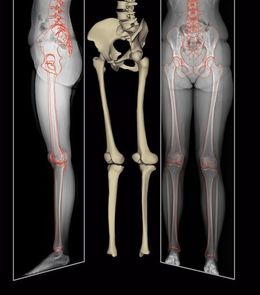Stature Lengthening- Preoperative Planning and Physiotherapy
Author: Dimitrios Giotikas MD, PhD
Preoperative planning for stature lengthening consists of the following steps:
Surgical Assesment
During preoperative surgical assessment Dr Giotikas will examine you and will review the CT scannogram to determine which bones will be lengthened and for how much and whether or not soft tissue releases are going to be needed. Measurements include the length, alignment and any deformity of your bones (bowing or twisting). Depending on these features Dr Giotikas will suggest whether a Precise nail or a circular frame (Ilizarov or TSF) is more appropriate for you and why. Dr Giotikas will also examine the range of movement of your hip, knee, and ankle and the tightness of your muscles to determine whether some minor auxiliary procedures will be required in your case or not. These procedures refer to the lengthening of some tendons and they can be performed either from the beginning, i.e during the initial operation, or later during the lengthening phase, should they become necessary. Dr Giotikas will also ask you structured questions about your work, hobbies, and lifestyle in order to understand your functional needs.
Psychological assessment
 Psychological evaluation prior to any cosmetic procedure is advised in the updated Guidelines of NICE Institute of Clinical Excellence of the United Kingdom. This is done with a validated screening questionnaire (Cosmetic Procedures Screening Questionnaire- COPS) and according to the score, an interview with a psychologist may be advised. The main purpose is to distinguish those rare cases suffering from psychosis to whom stature lengthening will not improve the quality of their lives. It also serves the purpose of identifying the potential need for psychological support during the recovery period.
Psychological evaluation prior to any cosmetic procedure is advised in the updated Guidelines of NICE Institute of Clinical Excellence of the United Kingdom. This is done with a validated screening questionnaire (Cosmetic Procedures Screening Questionnaire- COPS) and according to the score, an interview with a psychologist may be advised. The main purpose is to distinguish those rare cases suffering from psychosis to whom stature lengthening will not improve the quality of their lives. It also serves the purpose of identifying the potential need for psychological support during the recovery period.
Informed consent
At Athens BJR, we abide to GMC guidelines about the informed consent process. Time is the first thing that you have to change perspective about, if you are considering cosmetic limb lengthening. Stature lengthening will always seem like a time-consuming process but it is important to remember that the body needs 5 years to adapt to a natural 6 cm increase of height during childhood and adolescence. So, what it seems like a time-consuming method, it actually is a rapid, shocking change for the body, made possible only by means of science and technology and subjected to the restrictions of the human nature, both mental and physical. The whole procedure is explained thoroughly and in great detail and any questions that the patient might have are answered. Emphasis is given on the physiotherapy protocol and on the weight bearing restrictions (if there are any). The expectations are agreed and the possible risks and complications are analysed until the patients feel confident to sign the informed consent form.
Anaesthetic assessment
The Anaesthetist will make sure that no problems which could disturb the anaesthesia will arise, or will preempt any potential issues. He will also determine which type of anaesthesia and post-operative pain management would be right for each patient.
The surgery can be done with general anaesthesia (fully asleep) or regional (spinal, epidural anaesthesia with the patient awake.) This is anaesthetist’s decision, but if you have any preference you are encouraged to request it. If there is no contraindication, our anaesthetic team will be happy to follow your preference.
Preoperative physio consists of a muscle stretching program. Although there is evidence showing that stretching effect doesn’t last more than 24 hours, adopting a routine of regular exercising helps muscles improve their elasticity so they can more easily adapt to their increased working length during and after the lengthening of the limb. It is also related with less possibility of developing joint contractures during and after the lengthening.
You will also be instructed to quit smoking. If you have difficulty with quitting smoking, a nicotine replacement therapy can be prescribed.


